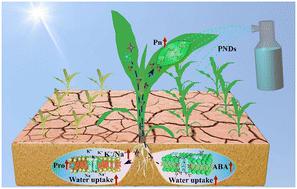当前位置:
X-MOL 学术
›
Environ. Sci.: Nano
›
论文详情
Our official English website, www.x-mol.net, welcomes your feedback! (Note: you will need to create a separate account there.)
Physiological and molecular level understanding of advanced carbon dots to enhance maize drought tolerance: modulation of photosynthesis and signaling molecules
Environmental Science: Nano ( IF 7.3 ) Pub Date : 2022-08-12 , DOI: 10.1039/d2en00176d Chuanxi Wang , Hanyue Yang , Le Yue , Wei Sun , Feiran Chen , Xuesong Cao , Xiaoli Zhao , Fengchang Wu , Zhenyu Wang , Baoshan Xing
Environmental Science: Nano ( IF 7.3 ) Pub Date : 2022-08-12 , DOI: 10.1039/d2en00176d Chuanxi Wang , Hanyue Yang , Le Yue , Wei Sun , Feiran Chen , Xuesong Cao , Xiaoli Zhao , Fengchang Wu , Zhenyu Wang , Baoshan Xing

|
Drought stress is posing a severe threat to the global crop production. Herein, we report a solution to combat drought stress by employing advanced carbon dots, which are rationally designed with the concerted strategies of nitrogen doping and surface modification with polyacrylic acid, defined as PNDs. Doping carbon dots (CDs) with nitrogen (N) improves the ability to eliminate reactive oxygen species (ROS), and polyacrylic acid could facilitate the penetration of CDs through plant cells into chloroplasts. Under drought stress, foliar-applied PNDs (5 mg L−1) could decrease ROS accumulation, substantially improve the net photosynthesis rate (206.8%), and promote water uptake by increasing abscisic acid (ABA, 6.9%) and proline (Pro, 36.3%) in roots of maize, demonstrating multiple positive functions. PNDs could recover maize growth under drought stress by modulating photosynthesis and signaling molecules. The results of dynamic monitoring showed that ABA and Pro were synthesized in maize leaves first, and then accumulated in roots through long-distance transport. The elevated levels of ABA and Pro could promote aquaporin activity and maintain osmotic pressure in roots, thereby alleviating drought stress of maize. This work demonstrates that PNDs will be promising alternatives for sustainable nano-agriculture in responding to the global climate change and food security crisis.
中文翻译:

提高玉米耐旱性的高级碳点的生理和分子水平理解:光合作用和信号分子的调节
干旱压力正在对全球作物生产构成严重威胁。在此,我们报告了一种通过采用先进的碳点来对抗干旱胁迫的解决方案,这些碳点经过合理设计,采用氮掺杂和聚丙烯酸表面改性的协同策略,定义为 PND。用氮 (N) 掺杂碳点 (CDs) 可以提高消除活性氧 (ROS) 的能力,聚丙烯酸可以促进 CDs 通过植物细胞渗透到叶绿体中。在干旱胁迫下,叶面施用的 PND (5 mg L -1) 可以减少 ROS 积累,显着提高净光合作用速率 (206.8%),并通过增加玉米根中的脱落酸 (ABA, 6.9%) 和脯氨酸 (Pro, 36.3%) 来促进水分吸收,表现出多种积极作用。PNDs 可以通过调节光合作用和信号分子来恢复干旱胁迫下的玉米生长。动态监测结果表明,ABA和Pro首先在玉米叶片中合成,然后通过长距离运输在根部积累。ABA和Pro水平升高可以促进水通道蛋白活性并维持根部的渗透压,从而减轻玉米的干旱胁迫。这项工作表明,PND 将成为应对全球气候变化和粮食安全危机的可持续纳米农业的有希望的替代品。
更新日期:2022-08-12
中文翻译:

提高玉米耐旱性的高级碳点的生理和分子水平理解:光合作用和信号分子的调节
干旱压力正在对全球作物生产构成严重威胁。在此,我们报告了一种通过采用先进的碳点来对抗干旱胁迫的解决方案,这些碳点经过合理设计,采用氮掺杂和聚丙烯酸表面改性的协同策略,定义为 PND。用氮 (N) 掺杂碳点 (CDs) 可以提高消除活性氧 (ROS) 的能力,聚丙烯酸可以促进 CDs 通过植物细胞渗透到叶绿体中。在干旱胁迫下,叶面施用的 PND (5 mg L -1) 可以减少 ROS 积累,显着提高净光合作用速率 (206.8%),并通过增加玉米根中的脱落酸 (ABA, 6.9%) 和脯氨酸 (Pro, 36.3%) 来促进水分吸收,表现出多种积极作用。PNDs 可以通过调节光合作用和信号分子来恢复干旱胁迫下的玉米生长。动态监测结果表明,ABA和Pro首先在玉米叶片中合成,然后通过长距离运输在根部积累。ABA和Pro水平升高可以促进水通道蛋白活性并维持根部的渗透压,从而减轻玉米的干旱胁迫。这项工作表明,PND 将成为应对全球气候变化和粮食安全危机的可持续纳米农业的有希望的替代品。


























 京公网安备 11010802027423号
京公网安备 11010802027423号